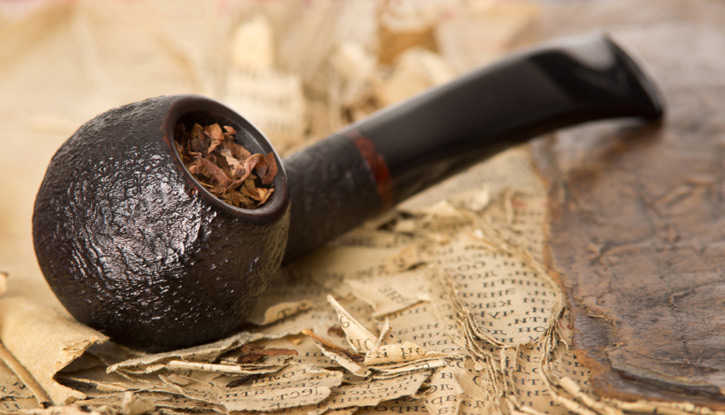G. L. Pease
 Early this morning, a dear friend packed a hired truck with boxes of pipes, tobacco, books, and all his other important belongings, preparing to set off eastward to make a new home on the other edge of the continent. I know we’ll see each other again, but I’m very much going to miss his company in the meanwhile. We’ve shared lots of good food, good drink, good conversation and laughter, almost always enveloped in a comforting fog of fragrant smoke.
Early this morning, a dear friend packed a hired truck with boxes of pipes, tobacco, books, and all his other important belongings, preparing to set off eastward to make a new home on the other edge of the continent. I know we’ll see each other again, but I’m very much going to miss his company in the meanwhile. We’ve shared lots of good food, good drink, good conversation and laughter, almost always enveloped in a comforting fog of fragrant smoke.
Perhaps that’s the true magic of the pipe; it seems to catalyze fellowship whenever it’s present in the company of good people. Of those I hold close in my life, many have come to that place over a bowl or twenty. The pipe has a way of bringing people together through a common passion, whilst simultaneously creating something of a sacred space in which to discover our overlapping interests, and to peacefully explore both our similar and our divergent views.
And, on days like today, I find in the ever changing clouds an opportunity to quietly reflect on wonderful memories. I dedicate this bowl, and this month’s column to my friend as he sets off to write the next chapters of a vibrant, multi-hued life, forging new friendships and new adventures along the way. Bonne route. À la prochaine.
Onwards!
Mike offers a bit of interesting food for thought: Thanks for answering my question about re-blending your old, established blends given current learning (cf: Ask G.L. Pease, Number 39). You would seem to be so inclined only if the blend could be substantially improved such as the re-blending of Robusto. You also wrote about reworking other blends given a new idea, and that although your curiosity has been so aroused many times, the results have been less than satisfactory, and that experimentation ended there.
But I ask you, given your 50+ blends, all of which that I’ve smoked are in a class of their own regarding flavor and complexity, why not Cumberland, Cumberland XX (I believe there was a Cumberland X), Cumberland XY? The possibilities, and number of blends, are endless. 50+ blends could become 150 in a year’s time. Then too you could also crossbreed the existing blends. Think of the dollars and prestige that would accrue given your conquering the pipe tobacco market. You could become filthy rich. Just an idea, a bit tongue-in-cheek at that :).

A: Mike, I appreciate the irony, and there’s more than a little grist for the mill, there. When I started doing this, I did so with the notion in mind that if I could produce that single, perfect blend, it would be enough, but knowing that to be something of a fool’s errand, I set out to do ten, twelve, maybe a Baker’s Dozen. That’s all I’d need to do, right? Perhaps not something for everyone, but something for enough people, and I could then just relax and let the millions roll in.
After all, Rattray had a mere handful of blends, and the inimitable House of Sobranie had just a few. Even the revered Dunhill, despite thousands of bespoke mixtures and special blends that could be custom ordered, relied on only a few well-known and mostly respected blends — we’ll ignore the drydocked, barnacle festooned Royal Yacht, one of the most polarizing blends ever to find its way to tobacconists’ shelves.
So, on my way to vast fortunes, I figured I’d be in good company, right?
What I didn’t anticipate was that 1) my projection of the market and my share of it were rather optimistic, to say the least, and that 2) I would, once those few blends were done, have to face my own insatiable need to endlessly tinker with things. "I wonder what would happen if … "
Truth is, just about every blend feels, at least when I’m putting the final touches on it, that it might be the last one. Sometimes that feeling lingers for days, sometimes weeks or even months, but it never lasts. Something triggers the need to set to work on another, and it all starts over again. And again. Blend. Rinse. Repeat.
I’ve abandoned the notion of great riches, but the creative waters run somewhat deeper. Tom Eltang once said he’d stop making pipes when he fell dead over the shaping disk. In the same light, I guess I know where they’ll ultimately discover my body, though hopefully not for many, many years. But, 150 blends? Somehow, I don’t think so.
Arno writes: A fellow pipe smoker I know owns a tin of Germain’s Special Latakia flake which he has open for 2 years now. And still the tobacco inside has not dried out and is perfectly smokeable. I also experienced this with McClelland’s Blackwoods Flake. I think this is because of propylene glycol that is used to keep the tobacco moist. But does this stuff diminishes the quality of the used leaves and can it be hazardous to health in this quantities?
A: First things first. PG is not the only humectant used by tobacco producers. The addition of sugars, often in the form of molasses, honey, or invert syrups, as well as glycerin, can also keep a tobacco from drying quickly. If you’re not in an arid climate, cased tobaccos can hold on to their moisture with the tenacity of a terrier. In fact, I’ve often heard from smokers in humid climes that they have the opposite problem, finding it nearly impossible to dry their tobaccos sufficiently to smoke optimally.
I once researched the relationship of relative humidity to tobacco moisture content, and found that at 55-65% RH, many tobaccos will equilibrate very close to the 12-13% moisture content that we like for smoking. Not too bad. If the tins are kept tightly sealed, and the RH of your environment is within that range, the tobacco won’t dry very quickly, or very much. So, there very well could be other reasons besides PG that are responsible for the apparent immortality of these tobaccos.
Where PG is most often used is in aromatic tobaccos, as it makes an excellent carrier for flavoring and aroma components. Whether or not it diminishes the quality of the leaf is subject to much discussion. Personally, I don’t particularly like the taste of the stuff, or the way it affects burning characteristics, so I don’t use it. As to any potential health risks, I can’t really say. It’s generally regarded as safe for use in foods, but I haven’t found data that discuss its safety when burned, but the amounts used in all but the goopiest tobaccos are probably not high enough to worry about.
Tony asks: Greg, I have about a half dozen old Grabows, (before paper filters), that I am thinking about sending out to be cleaned and freshened up. These pipe haven’t been smoked since 1973 until I received them a couple years ago. I did the salt and alcohol thing on them all and they’re nice well seasoned smokers.. They’re from a friend who passed away and his wife gave me all his pipe stuff. Do you think a company like Walker Briarworks would kinda laugh and want to send them back as not worth the trouble?
A: They’re your pipes, and it’s your money. I doubt any reputable restorer would refuse to work on these pipes, especially if you explain the circumstances. I’ve heard of restorers doing some all but superhuman things with pipes that were in terrible condition, but that had sentimental value to their owners.
But, if you’ve cleaned them already, and they’re smoking well, why send them out? Smoke them and enjoy them. If, on the other hand, you do decide you want to send them for professional help, talk to the restorer, first. If he doesn’t want to do the job, keep looking. Someone else will.

James writes: I was gifted a tin of Ravens Wing a year ago with a date of 2004. I was wondering if this tobacco has now reached its premium condition or should it be aged for another few years?
A: It’s going to be great, now, and is absolutely ready to smoke. While it probably has a few years left before it starts to get really soft, if I had it, I’d smoke it. I think it’s better to smoke a tin that may be a little younger than optimal, and wonder what it might become, than to smoke it after it’s over the hill, and lament what it must have been. Enjoy!
Ed pens: I would be very interested to read your views on two fairly popular trends in pipe construction. I have noticed that strawberry wood and morta have replaced the traditional briar in a growing minority of artisan pipes. Have you tried either and, given that Italian makers with perhaps the best access to quality briar are prominent in this trend, does it warn us that quality briar is becoming less available or are they just very innovative?
The second trend is the reverse calabash – have you tried one (even I can not see any portents of doom in this trend) and why “reverse”? Although as yet I have not tried the exotic woods I have a Radice reverse calabash and it is no better or worse than my Junebug from the same maker of about the same dimension, both being excellent instruments of combustion.
A: I have a couple of morta pipes made by Trever Talbert, and find them to be excellent and interesting smokes. Both of mine are quite small, but they’re very well constructed, and offer a pleasant diversion from the briar. In some ways, they almost seem to turbocharge the flavors of the tobacco, which I’ve never quite understood; the sample is too small to know whether this phenomenon is a property of the material, or if it’s just a side-effect of how these are made, but I enjoy them.
I haven’t yet smoked a pipe made from strawberry tree (Arbutus sp.), but I’ve looked at many. The wood tends to produce deep, craggy, characterful sandblasts, and pipe makers I’ve spoken with about it enjoy using it as an additional alternative to briar, not as its replacement. There still seems to be plenty of briar available, and unless the pipe market grows dramatically, that’s not likely to change in the near future, so chalk the investigation of alternative woods up to exploration for its own sake.
As for the so-called "reverse calabash" pipes, they’re sort of new, and they’re relatively trendy, but do they make a difference? I have to say they do.
I have a pair of Radice/NeatPipes chubby billiards, one conventionally drilled, the other an example of the charming AeroBilliard. Both pipes have nearly identical geometries, and both are splendid smokers. Because of the way the smoke expands and cools in the second chamber of the Aero, the flavor experience is noticeably different from that of the conventional ones. In my albeit limited experience, the taste is more detailed, but also softer and more nuanced. I agree that the Aero isn’t "better" than its counterpart, but it offers a smoking experience that is sufficiently different that I’m led to believe that these double-chambered pipes are worth exploring for those so inclined.
That’s it for another fun-filled episode. Stay tuned for next month’s. Same Bat-time, same Bat-channel. And, keep those cards and letters coming!
-glp
 Since 1999, Gregory L. Pease has been the principal alchemist behind the blends of G.L. Pease Artisanal Tobaccos. He’s been a passionate pipeman since his university days, having cut his pipe teeth at the now extinct Drucquer & Sons Tobacconist in Berkeley, California. Greg is also author of The Briar & Leaf Chronicles, a photographer, recovering computer scientist, sometimes chef, and creator of The Epicure’s Asylum. See our interview with G. L. Pease here. |



















I must say, best article yet Greg! I love Q and A especially from master carvers and blenders. I saw something in here that I’d like to elaborate a little more on, reverse calabashes. I must admit at first I thought it maybe a passing fad like the Devil Anse pipe that everyone seems so infatuated with. I will say that after receiving mine, this pipe is here to stay. You wouldn’t think that a chamber like that would make such a difference on the overall smoke, but I does. It does in almost every aspect. Blends that I once found to bitey or intense, completely mellowed. You also don’t realize the condensation that gathers inside of a pipe until you own one. Here is an example. I love Sam’s Flake but sometimes find the orientals a little harsh on the palate. In a reverse it takes away the bite and allows a more in depth subtle sweetness to develop from the orientals. This goes for a lot of blends. VaPers and VAs lose the nip and latakias become less smokey. I feel these should be a staple item in every piper’s collection. As for having revised blends?? Meh…..I think what GLP is doing is top shelf in every aspect and should remain on the path its going. Life would be lame without ya Greg!!!! BTW……waiting patiently……we all are Greg!
Thanks for the feedback, Erik. It’s good to see someone with more experience with the RC pipes weigh in, and know that my own perceptions aren’t isolated to my sample of one. 😉
Thank you for the answer Mr. Pease 🙂
I lift, also, tonight’s bowl in your friend’s honor. May our collective embers light his way safely Eastward.
As always, thanks for the great read.
Greg, Thanks for the answer, well all the answers; another great article. Relieved to hear no underlying shortage of quality briar and shall be on the lookout for a suitable morta (had a look at Trever Talbert’s website which was interesting but currently no pipes) and probably one made from the strawberry tree. Perhaps on reflection I was a bit hard on my reverse calabash – although I never accused it of anything worse than being equal to a Junebug, which is a pretty exacting standard. However, it may not have been a fair comparison in that both were dedicated to one tobacco (GLP Robusto) but the Aero for much less time and I find that taste does gradually build and change with time – much of the reason I try to keep dedicated pipes for absolute favourite tobaccos.
Admitting one possible premature judgement brings me to admitting two definite premature misjudgements. Firstly in response to Greg’s other article (Out of the Ashes April 2014) I dissented from his pairing of a Junebug with Abingdon but later gave the pairing one last chance (I had mislaid my other Abingdon pipe) and the result was sublime. When I found my other Abingdon pipe I tried it and the tobacco (well what little was then left of it -here our Summers top out at 80F and a great traditional mixture burns a treat round about twilight and this far North we get long twilights) had come on quite a bit but the Junebug was in a class of its own. My second, and more culpable misjudgement, involves Key Largo which I accused of biting (last episode of this article), but, following Greg’s suggestion in the same Out of the Ashes, I tried in a very different pipe (a Gabriele slightly bent squashed tomato with a mixed history of sublime and poor smokes with Robusto) with marvellous results. Subsequently I tried it in another pipe with similar results, perhaps the main factor is that I need a less open draw with Key Largo. I have to admit that there was an element of exasperation in my earlier reaction to Key Largo not at least partly matching the performance for me of its nearest sibling Robusto. So Mea Culpa and a frantic bit of cellar building, particularly Key Largo of which I currently hold almost none.
The funny thing is that the pipe in which Key Largo performed least well was the Junebug. After much consideration of its involvement in these three fiascos I have sentenced it to a life of dedication to Abingdon.
Regards and best wishes to your friend who has gone East,
Ed
I enjoyed this article and the accompanying pix very much. Still waiting for your latest creation(s) to appear on the market.